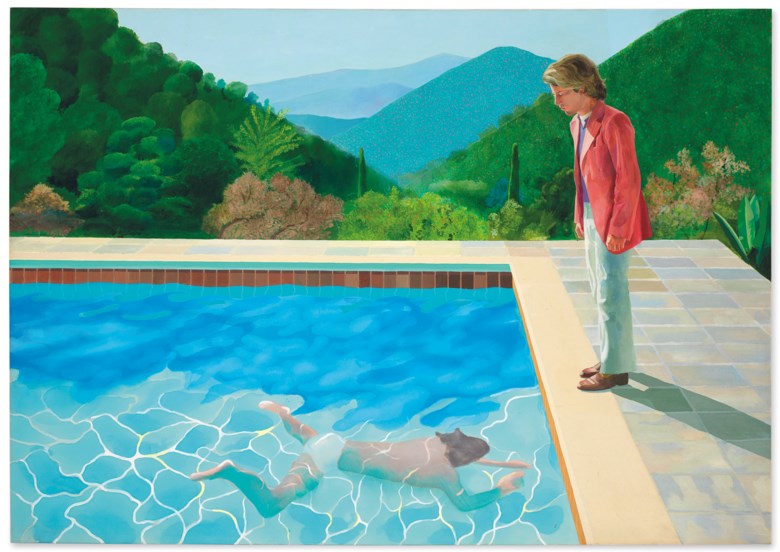Portrait of an Artist (Pool with Two Figures) is one of David Hockney’s most renowned paintings, which combines two of his most common motifs: the male figure and the swimming pool. In this article, Singulart discusses the story behind this masterpiece and its place in the context of Hockney’s life and career.
Who is David Hockney?

Born in Bradford, West Yorkshire, in 1937, Hockney attended the Royal College of Art in London from 1959 to 1962, where his boundary-pushing approach to the curriculum saw his talent recognized. He quickly rose to success as a pioneer of British Pop Art. In 1964 he moved to Los Angeles, which he described as the “promised land”, a place where he “flowered” and subsequently painted works such as A Bigger Splash which would come to define his style and British Pop Art. It is through his iconic, highly saturated acrylic paintings that he captured the essence of high living in California in the ‘60s. From here, Hockney’s oeuvre has gone on to span photography, landscape painting and experiments with new technology. Today, alongside Jeff Koons and Damien Hirst, he is one of the richest living artists.
The story behind Portrait of an Artist (Pool with Two Figures)
Portrait of an Artist (Pool with Two Figures) is one of David Hockney’s most famous works and in November 2018 it sold for $90.3 million, at the time the highest price ever paid for a work by a living artist. The large scale (2.1m x 3m) acrylic on canvas painting depicts two male figures, one underwater and the other standing fully-dressed beside the swimming pool looking down on the swimming figure. Against the backdrop of luscious green hills and trees which disappear into the hazy blue sky cuts a shimmering blue swimming pool. Hockney employs his characteristically saturated colours and simplified, flattened shapes to conjure up this iconic image.

The composition explores two of the major themes of Hockney’s work from the 1960’s and 1970’s: the male figure and swimming pools. The idea for the composition was inspired by the chance juxtaposition of two photos on Hockney’s studio floor, one of a figure underwater and the other of a man looking down at the ground. Hockney stated: “The idea of painting two figures in different styles appealed so much that I began painting immediately.” However the composition proved more complex than expected and his first attempt was discarded before he decided to return to it in April 1972, four weeks before the opening of an exhibition of his work in New York. He traveled to a villa near Saint Tropez to stage the composition and take photographs with a friend and his assistant before returning to his London studio and photographing further studies with his former lover, Peter Schlesinger, wearing a pink jacket in Kensington Gardens. He then painted for eighteen hours a day over two weeks to complete the painting before the exhibition.
The inclusion of his former lover Peter Schlesinger in the composition, adds a layer of personal emotion to Portrait of an Artist (Pool with Two Figures), making it all the more powerful. As he looks down at the male figure in the pool, a figure other than Hockney, we sense the painter’s desire, melancholy and heartbreak set into the stillness of the sun-drenched setting.
David Hockney’s swimming pools
The motif of the swimming pool characterizes Hockney’s early works from the 60’s and 70’s and was something he came across by chance. When he first arrived in Los Angeles in the early 1960’s, he was struck by the sheer number of swimming pools in the city. In contrast to England where they are considered a luxury, in Los Angeles they were commonplace. They also presented Hockney with an interesting formal challenge, that of representing water and in particular the surface of the water, which constantly changes and avoids description. In Portrait of an Artist (Pool with Two Figures) he depicts the movement of the water’s surface, caused by the swimmers movements, with wavy white lines cutting through the blue and patchwork shadows. He also captures the distorting effect of the water on the swimmer’s body, which contrasts sharply with the clarity of the figure in pink above.
















